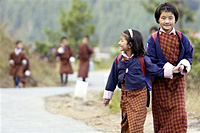




Experts have quarreled for centuries over how best to measure a country’s performance: economic output or average life expectancy? years of compulsory education or number of children per family? or perhaps, as the tiny Himalayan kingdom of Bhutan believes, Gross National Happiness is the way to go.
Proclaimed by Bhutan’s king in 1972 as a standard for the country’s well-being, Gross National Happiness (GNH) has been proposed as a model for other countries as well. A conference last year in Nova Scotia drew participants from as far away as South America, Africa, Iceland, and India.
In a paper presented in Nova Scotia, Bhutanese Home Minister Lyonpo Jigmi Thinley described the four supports, or “pillars,” of GNH: socioeconomic development, environmental preservation, cultural promotion, and good governance.
“GNH recognizes that happiness can be realized as a societal goal,” Thinley said. “It cannot be left as an individualized goal… as yet another individual, competitive good.”
We are also helping them improve their capacity to measure social indicators, economic indicators, and how to translate that idea of Gross National Happiness into actual statistics, which is very difficult,
Tashi Zangmo, raised in a village in eastern Bhutan and now a doctoral candidate in education at the University of Massachusetts, took part in last year’s conference. In an interview with Radio Free Asia, she said Bhutan’s “four pillars” were in place before 1972.
“It’s just that we didn’t name it,” she said. “The government didn’t think of naming it.”
Bhutan has always protected its environment, Zangmo said. Bhutan’s forests are protected by laws limiting the number of trees that can be cut down to build houses. “We can go anywhere and drink the stream water,” she added.
Zangmo pointed in particular to Bhutan’s traditional self-sufficiency in agriculture.
Seventy-nine percent of Bhutan’s people are still farmers, Zangmo said. “Each one of those farmers has a roof over their head and a piece of land, and they have been cultivating those plots of land for many centuries.”

Other national income is generated by supplying hydroelectric power to India and by tourism, which is carefully monitored for its impact on Bhutan’s traditional culture, Zangmo said.
World Bank senior country officer for Bhutan Enrique Pantoja, also in an interview, said that the World Bank fully supports Bhutan’s vision for its development.
“We are also helping them improve their capacity to measure social indicators, economic indicators, and how to translate that idea of Gross National Happiness into actual statistics, which is very difficult,” Pantoja said.
Pantoja said the World Bank is spending $15 million in Bhutan this year to finance programs in education, road-building, rural development, and HIV/AIDS prevention. The programs themselves are run by Bhutan’s government, Pantoja said.
Noting that Bhutan’s King Jigme Singye Wangchuk has announced he will step down in 2008 to make way for democratic elections, Pantoja said “We expect [Gross National Happiness] will continue.”
Dr. Trudy Sable, director of the Office of Aboriginal and Northern Research at St. Mary’s University in Halifax, Nova Scotia, also participated in the Nova Scotia conference and has visited Bhutan.
Even small mountain communities in Bhutan, some two days’ travel off-road, do not appear impoverished, she said.
“I’ve been to enough development conferences now to know that this whole notion of what is ‘developing’ and what is ‘developed’ needs to be looked at very carefully,” Sable said.
Sable said she has tracked the results for Canada’s indigenous First Nations people of rapid modernization: poverty, social marginalization, drug abuse, and a high suicide rate.
Talking to the elders of these groups, however, she learned that there was a time when they were “happy”—a happiness based on their communities’ relationship to animal resources and to traditional views of proper conduct and respect.
A shared tradition, a “larger vision of interdependence,” is essential to a people’s happiness, Sable said.
However, some have questioned whether all of Bhutan’s citizens are included in its plans.
T. Kumar, Asia advocacy director for the Washington office of human rights group Amnesty International, said some 100,000 Bhutanese of Nepalese origin fled Bhutan about 10 years ago because of “abuses” there. They now live in refugee camps in the eastern part of Nepal.
“That’s a major, major issue,” said Kumar. “Basically, a section of the community was pushed out. Children in southern Bhutan continue to face discrimination in access to education because they belong to the Nepali-speaking community.”
Even among the country’s Buddhist majority, threats exist to cultural identity and cohesion.
The 1999 introduction of satellite television into Bhutan has been linked by the British newspaper The Guardian to a rise in drug use, crime, and other antisocial behaviors.
Encouraged to wear Bhutanese national dress in public, Bhutanese youth increasingly wear Western-style clothing at home.
Sable said she hears expressions of concern from Bhutanese friends about the accelerating pace of change. “Definitely. That’s in the air.”
For now, GNH seems a work in progress.
At the close of last year’s conference, Sable said, Bhutan’s home minister proposed a wait of two years before participants meet again, “Because we need to have an example of this now. We have to put this into practice.”
“So they’re now thinking they have to enact this by themselves. It’s not like it’s done. It’s more like a concept that they want to live by, but now they have to figure out how to do it.”
Original reporting by Richard Finney. Edited and produced for the Web by Sarah Jackson-Han.